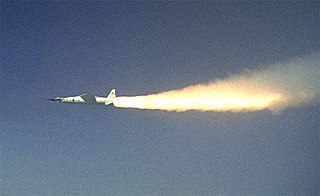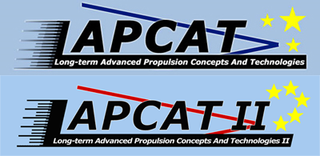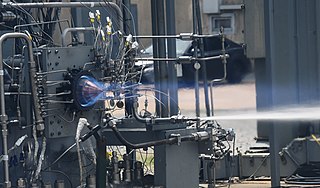Results and legacy
| | This section is empty. You can help by adding to it. (October 2023) |
Next Generation Launch Technology (NGLT) was a NASA Program Office established in 2002, to pursue technologies for future space launch systems. [1]
In 2004, NASA moved on to the Constellation Program, part of the Vision for Space Exploration.
"To pursue technologies for future space launch systems. NGLT will fund research in key technology areas such as propulsion, launch vehicles, operations and system analyses. NGLT is part of NASA's Integrated Space Technology Plan. The NGLT Program is sponsored by NASA's Office of Aerospace Technology and is part of the Space Launch Initiative theme that includes both NGLT and Orbital Space Plane. NGLT will focus on technology development to increase safety and reliability and reduce overall costs associated with building, flying and maintaining the nation's next-generations of space launch vehicles." [1]
NGLT covered : propulsion technology, launch systems (vehicle related technologies), and system analyses and engineering. [1]
Propulsion projects included : [1]
| | This section is empty. You can help by adding to it. (October 2023) |

A ramjet is a form of airbreathing jet engine that requires forward motion of the engine to provide air for combustion. Ramjets work most efficiently at supersonic speeds around Mach 3 and can operate up to Mach 6.

A scramjet is a variant of a ramjet airbreathing jet engine in which combustion takes place in supersonic airflow. As in ramjets, a scramjet relies on high vehicle speed to compress the incoming air forcefully before combustion, but whereas a ramjet decelerates the air to subsonic velocities before combustion using shock cones, a scramjet has no shock cone and slows the airflow using shockwaves produced by its ignition source in place of a shock cone. This allows the scramjet to operate efficiently at extremely high speeds.

The NASA X-43 was an experimental unmanned hypersonic aircraft with multiple planned scale variations meant to test various aspects of hypersonic flight. It was part of the X-plane series and specifically of NASA's Hyper-X program developed in the late 1990s. It set several airspeed records for jet aircraft. The X-43 is the fastest jet-powered aircraft on record at approximately Mach 9.6.

The Lockheed Martin X-33 was a proposed uncrewed, sub-scale technology demonstrator suborbital spaceplane that was developed for a period in the 1990s. The X-33 was a technology demonstrator for the VentureStar orbital spaceplane, which was planned to be a next-generation, commercially operated reusable launch vehicle. The X-33 would flight-test a range of technologies that NASA believed it needed for single-stage-to-orbit reusable launch vehicles, such as metallic thermal protection systems, composite cryogenic fuel tanks for liquid hydrogen, the aerospike engine, autonomous (uncrewed) flight control, rapid flight turn-around times through streamlined operations, and its lifting body aerodynamics.

SABRE is a concept under development by Reaction Engines Limited for a hypersonic precooled hybrid air-breathing rocket engine. The engine is designed to achieve single-stage-to-orbit capability, propelling the proposed Skylon spaceplane to low Earth orbit. SABRE is an evolution of Alan Bond's series of LACE-like designs that started in the early/mid-1980s for the HOTOL project.

LASRE was NASA's Linear Aerospike SR-71 Experiment which took place at the Dryden Flight Research Center at Edwards Air Force Base, California, until November 1998. The experiment sought to provide flight data to help Lockheed Martin validate and tune the computational predictive tools used to determine the aerodynamic performance of the Lockheed Martin X-33 lifting body and linear aerospike engine combination and to lay groundwork for a future reusable launch vehicle.
The integrated powerhead demonstrator (IPD) was a U.S. Air Force project in the 1990s and early 2000s run by NASA and the Air Force Research Laboratory (AFRL) to develop a new rocket engine front-end that would utilize a full flow staged combustion cycle (FFSC). The prime contractors were Rocketdyne and Aerojet.
Scramjet programs refers to research and testing programs for the development of supersonic combustion ramjets, known as scramjets. This list provides a short overview of national and international collaborations, and civilian and military programs. The USA, Russia, India, and China (2014), have succeeded at developing scramjet technologies.
The RS-83 was a rocket engine design for a reusable liquid hydrogen/liquid oxygen rocket larger and more powerful than any other. The RS-83 was designed to last 100 missions, and was intended for use on the first stage of a two-stage-to-orbit reusable launch vehicle.
The Future Launchers Preparatory Programme (FLPP) is a technology development and maturation programme of the European Space Agency (ESA). It develops technologies for the application in future European launch vehicles (launchers) and in upgrades to existing launch vehicles. By this it helps to reduce time, risk and cost of launcher development programmes.
Started in 2004, the programmes initial objective was to develop technologies for the Next Generation Launcher (NGL) to follow Ariane 5. With the inception of the Ariane 6 project, the focus of FLPP was shifted to a general development of new technologies for European launchers.
FLPP develops and matures technologies that are deemed promising for future application but currently do not have a sufficiently high technology readiness level (TRL) to allow a clear assessment of their performance and associated risk. Those technologies typically have an initial TRL of 3 or lower. The objective is to raise the TRL up to about 6, thus creating solutions which are proven under relevant conditions and can be integrated into development programmes with reduced cost and limited risk.

The Space Launch Initiative (SLI) was a NASA and U.S. Department of Defense joint research and technology project to determine the requirements to meet all the nation's hypersonics, space launch and space technology needs. It was also known as the "2nd Generation Reusable Launch Vehicle (RLV) program.". The program began with the award of RLV study contracts in 2000.

LAPCAT was a 36-month European FP6 study to examine ways to produce engines for a Mach number 4-8 hypersonic flight aircraft. The project ended in April 2008. It was funded by the European Commission research and development fund, and cost 7 million euros.
The Advanced Space Transportation Program (ASTP) is a NASA program to intentionally advance current space transportation system technologies, and innovate novel technologies, through intense research efforts that are intended to culminate in regularizing the outer space environment decades from now. The intense efforts aim to accelerate scientific and technological breakthroughs.
The Reusable Booster System (RBS) was a United States Air Force research program, circa 2010 to 2012, to develop a new prototype vertical-takeoff, horizontal-landing (VTHL) reusable booster and a new prototype expendable second stage to replace the existing Evolved Expendable Launch Vehicles (EELV) after 2025. The program was discontinued in 2012.

Since the founding of SpaceX in 2002, the company has developed four families of rocket engines — Merlin, Kestrel, Draco and SuperDraco — and since 2016 developed the Raptor methane rocket engine and after 2020, a line of methalox thrusters.

The Lockheed Martin SR-72, colloquially referred to as "Son of Blackbird", is an American hypersonic UAV concept intended for intelligence, surveillance and reconnaissance (ISR) proposed privately in 2013 by Lockheed Martin as a successor to the retired Lockheed SR-71 Blackbird. In 2018, company executives said an SR-72 test vehicle could fly by 2025 and enter service in the 2030s.
William Julius D. ("Bill") Escher was an aerospace engineer involved in the early development of the United States rocket programs and long time aerospace industry visionary. He was an internationally recognized expert in the field of high-speed airbreathing propulsion and hypersonic flight. He was a long been a proponent of combined-cycle propulsion systems for space access and his visionary 'Synerjet' concept is industry recognized. He wrote over a hundred technical papers on this subject and others such as hydrogen energy and lunar exploration.
Space Engine Systems Inc. (SES) is a Canadian aerospace company and is located in Edmonton, Alberta, Canada. The main focus of the company is the development of a light multi-fuel propulsion system to power a reusable spaceplane and hypersonic cruise vehicle. Pumps, compressors, gear boxes, and other related technologies being developed are integrated into SES's major R&D projects. SES has collaborated with the University of Calgary to study and develop technologies in key technical areas of nanotechnology and high-speed aerodynamics.

The SCE-200 is a 2 MN thrust class liquid rocket engine, being developed to power Indian Space Research Organisation's (ISRO) existing LVM3 and upcoming heavy and super heavy-lift launch vehicles. It is being developed by the Liquid Propulsion Systems Centre (LPSC) of ISRO, and is expected to have first flight in 2020s.

A rotating detonation engine (RDE) uses a form of pressure gain combustion, where one or more detonations continuously travel around an annular channel. Computational simulations and experimental results have shown that the RDE has potential in transport and other applications.